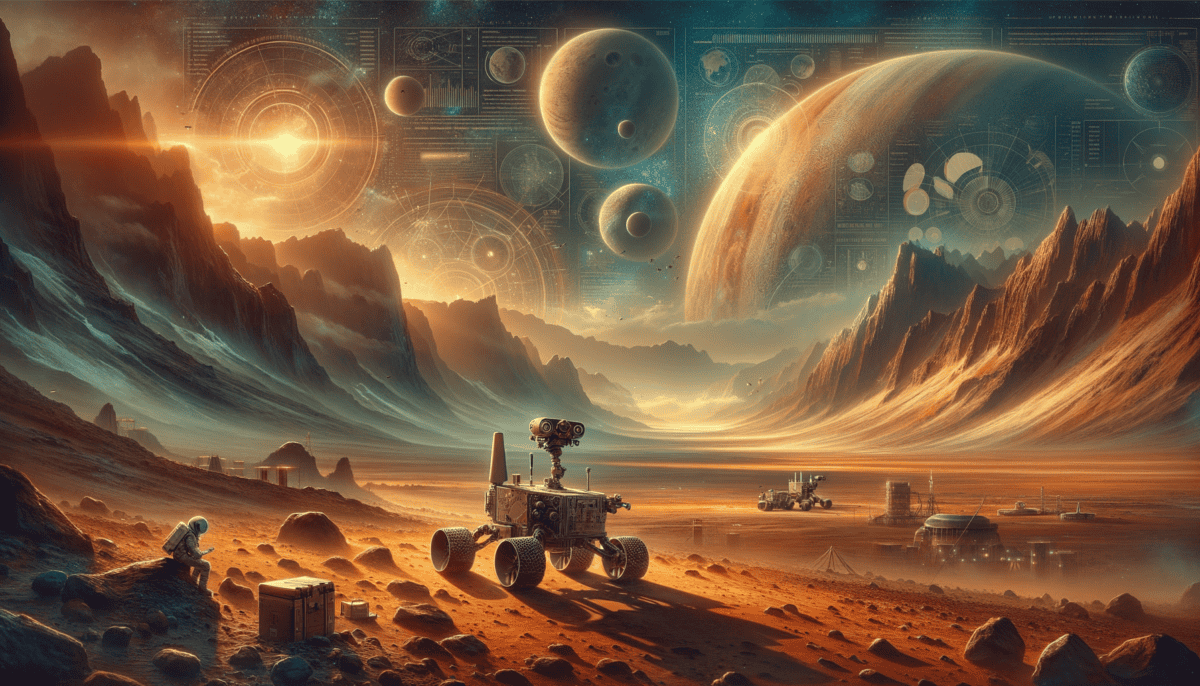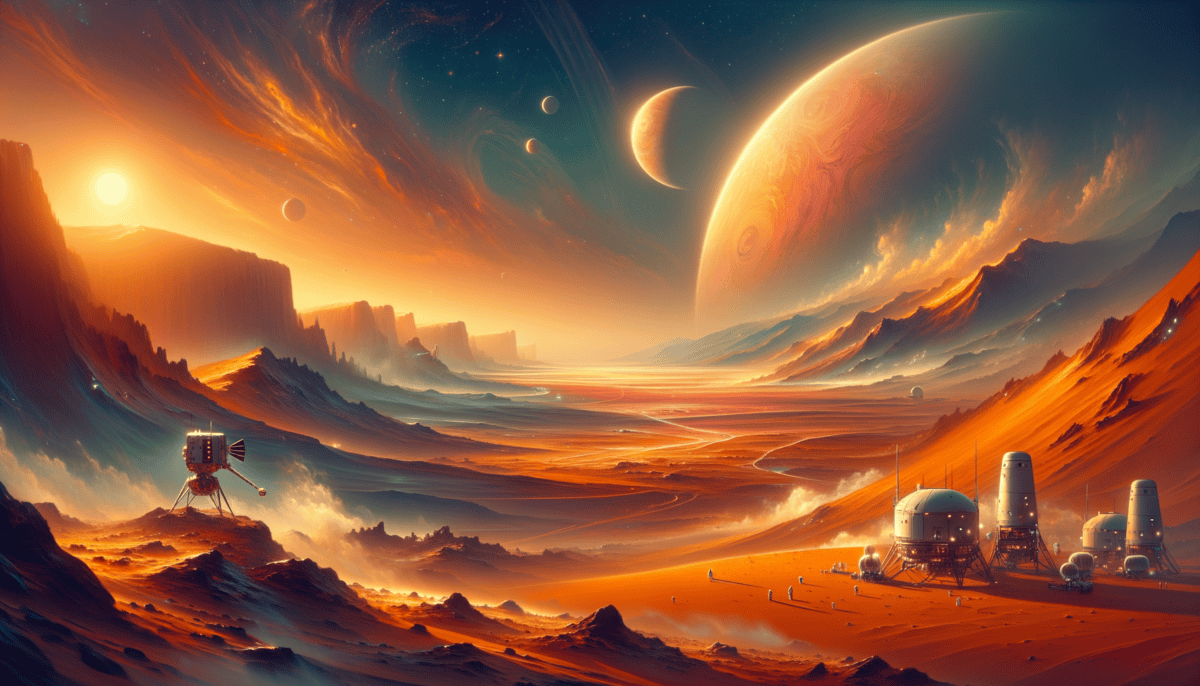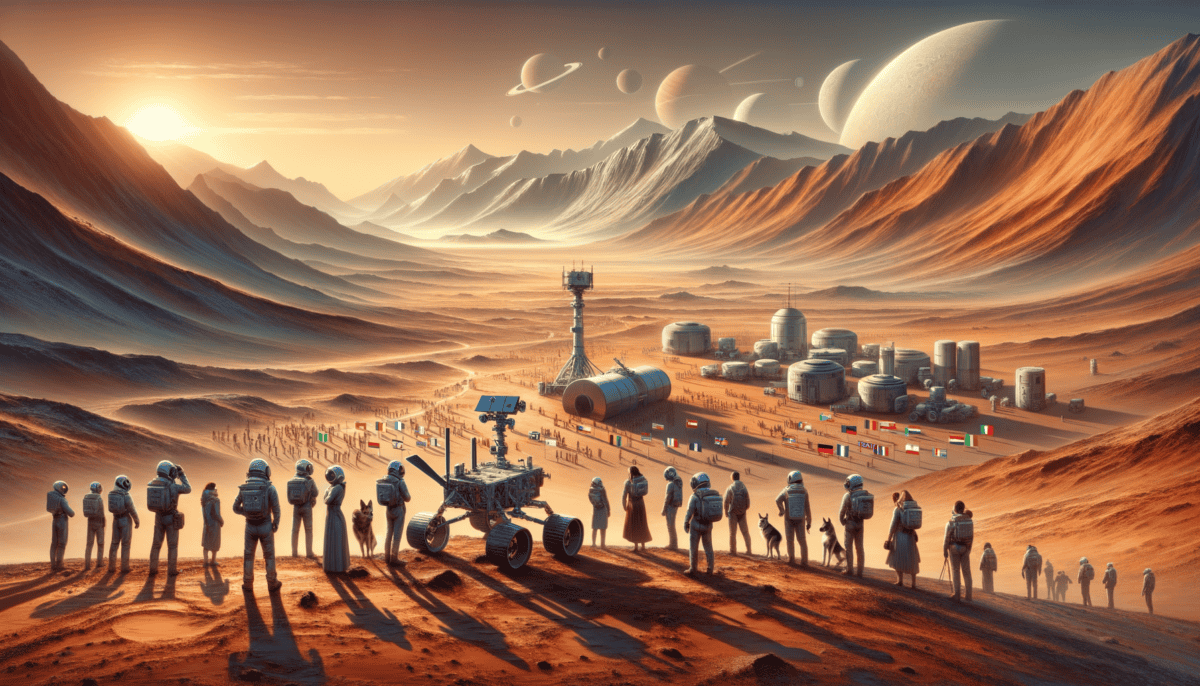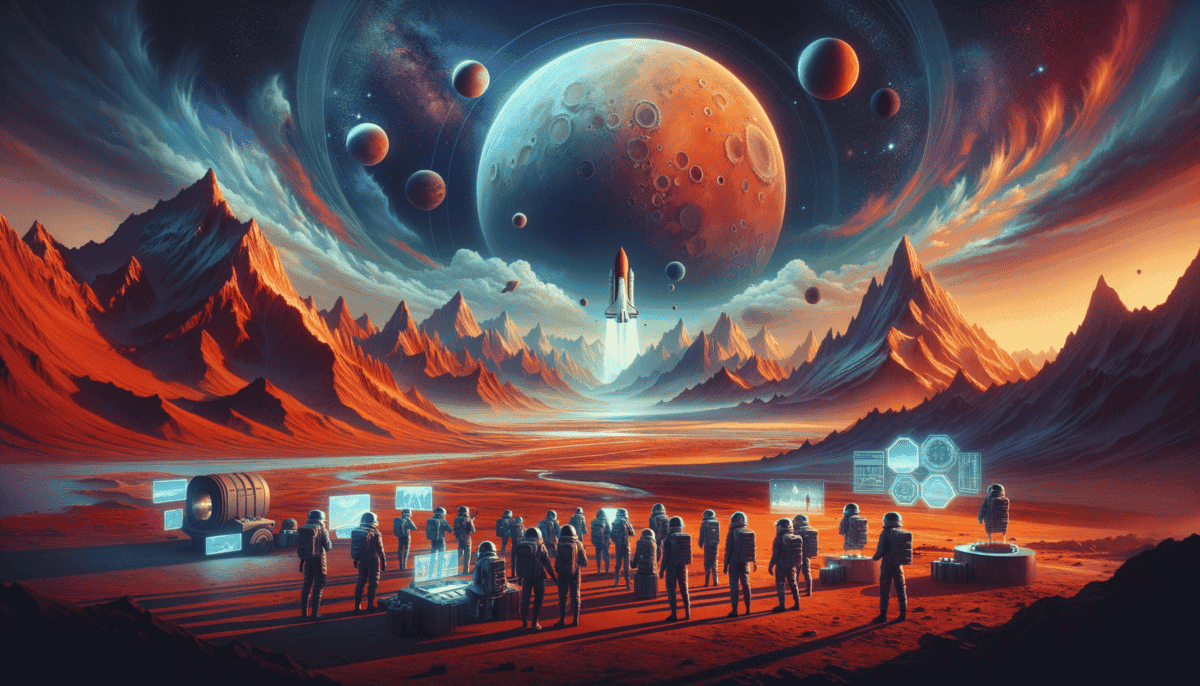Red Star Rising
Long ago, people looked up at the night sky and saw a bright red star that moved differently from the others. This wasn’t really a star – it was Mars! The red color made it special and easy to spot.
Little Sarah pointed at the sky one evening. “Daddy, why is that star so red?” she asked.
Her father smiled. “That’s Mars, sweetheart. The ancient Romans named it after their god of war because of its red color – just like a warrior’s shield!”
As time went by, people learned more about Mars. In 1609, an Italian scientist named Galileo did something amazing – he looked at Mars through a telescope! It was the first time anyone had seen Mars up close.
“Through my telescope, Mars wasn’t just a bright dot anymore. It was a real place!” – Galileo wrote in his notes.
The more people looked at Mars, the more curious they became. They saw white spots at the top and bottom of the planet – these were ice caps, just like on Earth!
Mars Through the Ages
Different people imagined different things about Mars:
• Ancient Egyptians watched it move across the sky
• Greeks thought it was a wandering star
• Modern scientists discovered it's a planet like Earth
In 1877, an Italian astronomer named Giovanni Schiaparelli made a very exciting announcement. He thought he saw lines on Mars that looked like canals! Could someone have built them? People started wondering if there might be Martians living there.
Sarah’s eyes grew wide. “Could there really be aliens on Mars, Daddy?”
“Well, honey,” her father replied, “we haven’t found any Martians, but Mars has many other exciting secrets. Scientists are still discovering new things about it today!”
• Mars is about half the size of Earth
• It has the biggest volcano in our solar system
• A year on Mars is 687 Earth days long!
As telescopes got better, we learned more about Mars. We could see its mountains, valleys, and even dust storms that cover the whole planet! ️
Today, we know Mars isn’t home to little green men, but it’s still an amazing place. It has huge canyons, giant volcanoes, and polar ice caps made of frozen water and carbon dioxide (that’s what makes your soda fizzy!).
Sarah looked up at the red planet one more time before bedtime. “I want to learn everything about Mars,” she declared.
“That’s wonderful!” her father said. “Because the story of Mars is just beginning. Scientists are sending robots there to explore, and someday, real people might visit Mars too!”
As Sarah drifted off to sleep, she dreamed about the mysterious red planet hanging in the night sky, waiting to share more of its secrets with Earth’s curious explorers.
Metal Explorers
The first robot to visit Mars was called Mariner 4. It flew past Mars in 1965, taking pictures that made everyone very excited!
“Look at these amazing pictures!” Dr. Chen showed her class. “This is the first time we’ve seen Mars up close!”
But flying past Mars wasn’t enough. We wanted to get even closer. So scientists built special robots called rovers. These rovers are like smart cars that can drive around on Mars!
Meet the Mars Rovers
Tommy raised his hand. “How many rovers are on Mars?”
“Let me tell you about our brave robot explorers,” Dr. Chen smiled.
First came Sojourner, a small rover the size of a microwave. It landed in 1997 and showed us we could drive on Mars!
Then came two sister rovers named Spirit and Opportunity. They landed in 2004. Opportunity was super strong – it worked for almost 15 years! That’s like a robot that keeps going and going and going.
“These rovers are like robot scientists. They take pictures, study rocks, and tell us what Mars is really like!” – Dr. Chen explained.
• They move very slowly – about as fast as a turtle
• They use solar panels to get energy from the sun
• They send pictures back to Earth every day
The biggest rover is called Curiosity. It’s as big as a car! It has special tools to look for signs that Mars might have once had tiny living things.
“But how do the rovers know what to do?” asked Maria.
“Scientists on Earth send them instructions every day,” Dr. Chen explained. “It’s like playing a video game, but very, very slowly because Mars is so far away!”
The newest rover is called Perseverance. It landed in 2021 with a tiny helicopter friend named Ingenuity. For the first time ever, we flew something on another planet!
Sometimes the rovers face big problems. Dust storms can cover their solar panels. The wheels can get stuck in sand. But just like real explorers, they keep trying!
“What happens if a rover breaks?” Tommy wondered.
“The rovers are very tough,” Dr. Chen assured them. “They’re built to handle the harsh conditions on Mars. And even when they stop working, they’ve already taught us so much about the Red Planet!”
The class looked at pictures the rovers had taken. They saw red rocks, dusty plains, and beautiful Martian sunsets. It was like looking through a window to another world.
“These brave robot explorers are just the beginning,” Dr. Chen said. “Each one teaches us more about Mars and helps us get ready for the day when people will visit the Red Planet!”
The students couldn’t wait to learn what other secrets the Mars rovers would discover next.
Red Rocks and Giant Mountains
Sarah stared at the picture of Mars on the classroom wall. “Why is Mars so bumpy?” she asked Dr. Chen.
“Those bumps are actually huge mountains and deep valleys!” Dr. Chen smiled. “Let’s explore the amazing landscapes of Mars!”
“How big is it?” Tommy asked excitedly.
“If you stood at the bottom, you couldn’t see the top because it’s hidden in the clouds! It’s three times taller than Mount Everest on Earth!”
The Grand Canyon of Mars
Dr. Chen clicked to the next picture. “This is Valles Marineris, the biggest canyon on Mars.”
“Wow! It looks like a giant scratch on the planet!” Maria gasped.
“It’s so big that if it was on Earth, it would stretch all the way across the United States! That’s like driving from New York to California.”
• Olympus Mons – Giant volcano
• Valles Marineris – Huge canyon
• Polar ice caps – Made of frozen water and dry ice
• Crater fields – Places where space rocks hit Mars
Detective Curiosity
The Curiosity rover has been like a detective on Mars, looking for clues about water. It found something exciting in a place called Gale Crater!
“What did it find?” the class asked together.
“It found rocks that could only have formed in water,” Dr. Chen explained. “This means Mars once had lakes and rivers, just like Earth!”
The students imagined what Mars might have looked like long ago, with water flowing through its valleys.
Mystery Rocks
“The rocks on Mars tell us stories,” Dr. Chen continued. “Some have tiny holes where bubbles of gas once popped. Others have layers like the pages in a book.”
The rover Perseverance is now exploring a special place called Jezero Crater. Scientists think it was once a lake!
“Could anything have lived there?” Sarah wondered.
“That’s exactly what we’re trying to find out!” Dr. Chen replied. “Perseverance is collecting rock samples that might tell us if tiny forms of life once existed on Mars.”
Changing Seasons
Just like Earth, Mars has seasons. When winter comes to Mars’ poles, it gets so cold that carbon dioxide from the air freezes into dry ice!
“In spring, this dry ice turns directly from solid to gas. It makes beautiful patterns in the sand that look like spiders from space! ️”
The class watched videos of dust devils dancing across Mars’ surface. These mini tornadoes help clean dust off the rovers’ solar panels!
“Mars is full of surprises,” Dr. Chen said. “Every time we look closer, we find something new and amazing.”
The students couldn’t wait to learn what other secrets were hiding in Mars’ red rocks and giant mountains.
The Search for Water
Tommy raised his hand eagerly. “Dr. Chen, you said Mars had water before. Is there still water there now?”
“That’s a great question!” Dr. Chen clicked to show a new picture. “We’ve found lots of ice on Mars!”
Ice Detectives
“Look at this!” Dr. Chen pointed to a white patch in the picture. “This is the north pole of Mars. It’s covered in ice all year long!”
“Is it like the ice in my freezer?” Maria asked.
“Some of it is water ice, just like in your freezer. But some is dry ice – frozen carbon dioxide. It’s so cold on Mars that the air itself freezes!”
Underground Treasures
Dr. Chen showed the class a special radar picture. “Our spacecraft can see through Mars’ surface. They found something amazing – huge underground lakes of frozen water!”
“If we melted all the ice on Mars, we could fill a small ocean!” Dr. Chen explained.
• At both poles
• Underground ice lakes
• Inside certain rocks
• In morning frost
Morning Frost
The Curiosity rover sent back pictures of something sparkly one morning. “Look what happens when the sun rises on Mars,” Dr. Chen showed them.
“It looks like glitter!” Sarah exclaimed.
“That’s frost! Just like on cold mornings here on Earth. When the sun comes up, it turns into vapor and disappears.” ✨
Why Water Matters
“Water is super important,” Dr. Chen explained. “Without it, we can’t live on Mars. We need it to drink, grow food, and make oxygen to breathe!”
Tommy’s eyes got big. “So if we find enough water, we could live there?”
“That’s what scientists are working on! They’re planning ways to use Mars’ ice to help future astronauts survive.”
Water Mysteries
The Phoenix lander made an exciting discovery near Mars’ north pole. It dug into the soil and found ice just below the surface!
“The ice disappeared before our eyes,” Dr. Chen showed them the pictures. “It turned straight into vapor in Mars’ thin air.”
Sarah raised her hand. “But where did all the water go? Mars used to have lakes and rivers!”
“Most of it froze underground or escaped into space,” Dr. Chen explained. “Mars lost its magnetic field long ago, which helped its water and air drift away.”
Future Water Hunters
New missions are being planned to study Mars’ ice. Some will dig deep underground to learn more about these frozen treasures.
“Maybe one day,” Dr. Chen smiled, “we’ll find a way to use this ice to make Mars feel a little more like home.”
The class looked at the pictures of frost and ice on the red planet, imagining future astronauts turning Mars’ frozen water into life-giving resources.
Building a New Home
The classroom buzzed with excitement as Dr. Chen unrolled a large poster showing colorful drawings of Mars bases.
“Today, we’re going to talk about living on Mars!” Dr. Chen announced with a smile.
• Strong walls to protect from dust storms
• Special air filters
• Places to grow food
• Room for sleeping and working
• Areas for exercise and fun
Safe and Cozy
“But Dr. Chen,” Maria asked, “won’t it be super cold on Mars?”
“You’re right! That’s why we need special houses.” Dr. Chen pointed to a dome-shaped building in the picture. “These homes will keep astronauts warm and safe.”
“Think of it like a super-strong snow globe that protects everything inside!”
Growing Space Food
Tommy pointed at green patches inside the dome. “Are those plants?”
“Yes! We’ll need to grow our own food on Mars. Scientists are already practicing with special greenhouses on Earth.”
“What kind of food will they grow?” Sarah asked.
“Lettuce, tomatoes, potatoes – even pizza herbs!” Dr. Chen laughed as the children’s eyes lit up. “The first Mars salad was already grown in a test garden!”
Making Air to Breathe
“Remember how Mars doesn’t have much air?” Dr. Chen drew on the board. “We’ll need machines to make oxygen, just like trees do on Earth.”
“We already have a small machine on Mars doing this right now!” she added excitedly. “It’s called MOXIE, and it turns Mars air into oxygen!”
Working Together
“Look at all these flags,” Dr. Chen showed them another picture. “Countries all over Earth are working together to plan Mars missions.”
“Like a big team?” Maria asked.
“Exactly! Scientists from different countries share their ideas to solve problems.”
Living in Space
“The astronauts will need to exercise every day,” Dr. Chen demonstrated by jumping up and down. “Mars has less gravity than Earth, so their muscles need extra work!”
“Will they get to play sports?” Tommy wondered.
“They sure will! But jumping on Mars will feel super funny – you can jump three times higher than on Earth!”
Getting Ready
Dr. Chen showed videos of people training for Mars. Some lived in special houses in the desert, practicing what life on Mars might be like.
“They wear space suits outside, grow their food, and fix their own equipment,” she explained. “Everything they learn helps us plan better Mars homes.”
Sarah raised her hand. “When will people really live on Mars?”
“Space agencies are planning the first human missions now,” Dr. Chen said. “They want to send people to Mars in the next ten years!”
The children gazed at the pictures of future Mars homes, imagining themselves bouncing around in the red dust, growing space tomatoes, and waving back at Earth through their dome windows.
The Next Giant Leap
The spring science fair buzzed with energy as kids showed off their Mars projects. Dr. Chen smiled proudly at her students’ creative displays.
Young Space Dreamers
“Look what I made!” Tommy pointed to his model of a Mars rover made from recycled materials. It even had a tiny camera made from a bottle cap.
Maria stood next to her greenhouse design. “I figured out how to grow tomatoes using special lights, just like they’ll do on Mars!”
• Mars has the biggest volcano in our solar system
• There might be underground lakes
• A Mars year is 687 Earth days
• You can jump three times higher on Mars
• Mars has two tiny moons
Special Visitors
Sarah gasped as two real astronauts walked into the gym. They wore blue flight suits with NASA patches.
“Hello, future Mars explorers!” The first astronaut waved. “We heard about your amazing projects.”
“Your ideas could help us plan real missions to Mars!”
Questions and Dreams
“What’s the most exciting part about going to Mars?” Tommy asked.
The second astronaut smiled. “Being the first humans to walk on another planet. Imagine taking that first step!”
“Are you scared?” Maria wondered.
“A little,” the astronaut admitted. “But being brave means doing important things even when we’re scared.”
Future Plans
Dr. Chen pointed to a big timeline on the wall. “Look how far we’ve come! From looking at Mars through telescopes to sending robots there.”
“And soon,” the first astronaut added, “we’ll build homes on Mars. Maybe some of you will help design them!”
Messages to Mars
The children wrote special notes to future Mars explorers. Sarah’s said: “Dear Mars astronauts, thank you for being brave. You’re showing us that dreams come true!”
Tommy wrote: “I want to drive a Mars rover someday. Please save some red rocks for me to study!”
A New Chapter
As the science fair ended, Dr. Chen gathered her students. “Remember when we first started learning about Mars? Now look at all you know!”
“Mars isn’t just a red dot in the sky anymore,” Maria said. “It’s our next home!”
The astronauts nodded. “That’s right. And the best part? The Mars story is just beginning.”
Outside, the evening sky glowed orange-red. A bright dot twinkled above – Mars, waiting for its next visitors. The children knew that someday, humans would call that distant world home. And maybe, just maybe, one of them would help make it happen.
Tommy squeezed his model rover. “To Mars?”
The whole class cheered together: “To Mars!”
And somewhere in the vast space between Earth and the Red Planet, robots continued their work, preparing the way for humanity’s greatest adventure. The Mars dream that started with ancient stargazers would soon become reality, one small step at a time. ✨






